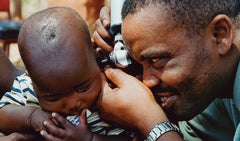In the U.S., if someone experiences loss of hearing, they simply get a hearing aid. However, in low income countries, that scenario simply isn’t possible.
The Problem
Loss of hearing is a problem that has affected those in developing countries the most. According to a report by the World Health Organization (WHO), 80% of those individuals who have experienced loss of hearing live in low or middle income countries. Yet, the lack of trained personnel and the prohibitive cost of devices make it almost impossible for those living with hearing disabilities to obtain and use these devices. As a result, less than 10% of the people who need hearing aids in these countries can obtain them.

Physician looking into the ear of a child who is suffering from hearing loss.
The Solution
Here, technology transfer, the act of transferring knowledge about some type of technology from places where the product market is saturated to places where need is still unmet, has been the model for addressing this problem. Based on recommendations from WHO, scientists aimed to build a target product that cost about $50 (the current price of hearing aids in the U.S. market is in the thousands of $), using ear molds that could be molded on the spot (so that the patient would not have to visit the clinic twice), and a rechargeable solar powered battery (to eliminate the need of costly batteries that need to be replaced weekly).
The Result
The end result was a product known as the Solar Ear, created by a Canadian entrepreneur Howard Weinstein. Solar Ear does not require an ear mold and eliminates the need for replaceable batteries due to its alternative source of energy. Yet, the technology itself is not a panacea for the disability gap that occurs in developing countries, for the lack of skilled healthcare workers to implant these devices may create a bottleneck in hearing aid distribution. Thus, the technology transfer of Solar Ear over to developing countries requires, not only knowledge of the product, but also a concerted effort to improve the healthcare system in these countries. These policy changes may be complex but are essential for making these devices accessible.
For the technology is only half the story.

Great technology example, and good job identifying that solving the problem goes beyond just the technology. I hadn’t heard of these devices, thank you for bringing them to my attention.